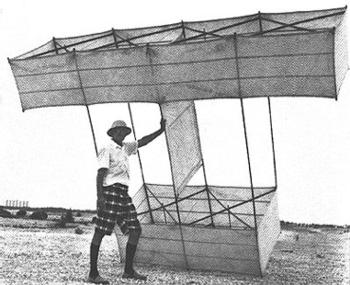

Harry C Sauls
Barrage Kite
From Trevor Saul
This article was originally published in the August 2004 edition of Soul Search, the journal of The Sole Society
Ed: Thanks to Trevor for pointing out this interesting web site and to Charles Hall for giving permission to reproduce information from his web site. Does anyone have a connection with this gentleman who was in residing in Pomona, California in April 1923?
 Sauls'
Barrage Kite is well known as an anti-aircraft device flown from merchant ships
in World War II, but the idea first began as an advertising scheme in the years
before. There are two documents concerning this famous kite's early history in
amongst the Paul Garber Papers at the Smithsonian Air & Space Museum.
Sauls'
Barrage Kite is well known as an anti-aircraft device flown from merchant ships
in World War II, but the idea first began as an advertising scheme in the years
before. There are two documents concerning this famous kite's early history in
amongst the Paul Garber Papers at the Smithsonian Air & Space Museum.
The first appears to be a first hand account from Harry Sauls of his invention and perfection of the kite as a way to fly advertising banners over popular resort areas. By 1938 the design was just about perfected, even down to a scheme for attaching giant letters to netting for attachment to kite.
A second document, from November 1942, records the early trials of the kite as an anti-aircraft weapon to be flown from merchant ships (much like a barrage balloon). By this time the name M. Vangrow appears as Saul's partner. The tests were conducted in Halifax Nova Scotia on board a merchant ship that was soon to sail out with an eastbound convoy and a mine sweeper.
Wartime service of Saul's kite, now known as Saul's Barrage Kite, is documented in this 1944 issue of Popular Science:
"Kites now comb the sky above our merchant ships, trailing in the paths of attackers the same kind of wire that is used on barrage balloons. The wire is invisible from a plane, but it will rip off a wing or foul a propeller. Knowing that, enemy airmen keep their distance. A kite is easier to launch and manoeuvre in a high wind than a balloon, does not slow a ship down so much, and costs less -- $108 as compared with $1,200 for a balloon. The box kites used are of aircraft fabric, with spruce struts and 2,000-foot lines. W/Bsn. H.C. Sauls, of the War Shipping Administration, experimented 12 years to perfect this type of kite, which was intended originally for displaying advertising signs. The Navy adopted it in 1941. Since then, more than 1,000 officers and seamen have been taught its use at the U.S. Maritime Service Kite and Barrage Balloon School in New York."
Key to photos:
Two men can launch an anti-plane kite in 10 or 11 minutes. The fabric is unfurled (1), and the 20 pieces are put together (2). Sailor puts in struts and the guideline is made fast (3). Men toss assembled kite from deck of the ship (4), and line is paid out from a winch (5) as it rises over the mast (6) to ward off enemy planes with its wing-shearing, propeller fouling cable.





